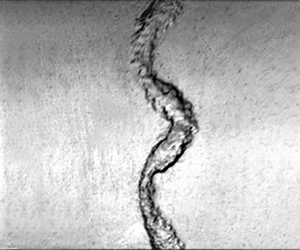Crossref Citations
This article has been cited by the following publications. This list is generated based on data provided by
Crossref.
Liang, Yu
and
Luo, Xisheng
2022.
On shock-induced evolution of a gas layer with two fast/slow interfaces.
Journal of Fluid Mechanics,
Vol. 939,
Issue. ,
Wang, Hui
Wang, He
Zhai, Zhigang
and
Luo, Xisheng
2022.
Effects of obstacles on shock-induced perturbation growth.
Physics of Fluids,
Vol. 34,
Issue. 8,
Liang, Yu
2022.
The phase effect on the Richtmyer–Meshkov instability of a fluid layer.
Physics of Fluids,
Vol. 34,
Issue. 3,
Wang, Yang
and
Dong, Gang
2022.
A numerical study of shock-interface interaction and prediction of the mixing zone growth in inhomogeneous medium.
Acta Mechanica Sinica,
Vol. 38,
Issue. 12,
Liang, Yu
2022.
Fundamental Studies of Shock-Driven Hydrodynamic Instabilities.
p.
103.
Zhang, Yibo
Zhou, Zhangbo
Ding, Juchun
and
Luo, Xisheng
2022.
Interaction of a planar shock wave with two heavy/light interfaces.
Acta Mechanica Sinica,
Vol. 38,
Issue. 9,
Cong, Zhouyang
Guo, Xu
Si, Ting
and
Luo, Xisheng
2022.
Experimental and theoretical studies on heavy fluid layers with reshock.
Physics of Fluids,
Vol. 34,
Issue. 10,
Zhang, Duo
Ding, Juchun
Si, Ting
and
Luo, Xisheng
2023.
Divergent Richtmyer–Meshkov instability on a heavy gas layer.
Journal of Fluid Mechanics,
Vol. 959,
Issue. ,
Zhang, Duo
Ding, Juchun
Li, Ming
Zou, Liyong
and
Luo, Xisheng
2023.
Effects of reverberating waves and interface coupling on a divergent Richtmyer–Meshkov instability.
Journal of Fluid Mechanics,
Vol. 975,
Issue. ,
Xu, Jinru
Wang, He
Zhai, Zhigang
and
Luo, Xisheng
2023.
Convergent Richtmyer–Meshkov instability on two-dimensional dual-mode interfaces.
Journal of Fluid Mechanics,
Vol. 965,
Issue. ,
Chen, Chenren
Xing, Yinuo
Wang, He
Zhai, Zhigang
and
Luo, Xisheng
2023.
Freeze-out of perturbation growth of single-mode helium–air interface through reflected shock in Richtmyer–Meshkov flows.
Journal of Fluid Mechanics,
Vol. 956,
Issue. ,
Singh, Satyvir
and
Torrilhon, Manuel
2023.
On the shock-driven hydrodynamic instability in square and rectangular light gas bubbles: A comparative study from numerical simulations.
Physics of Fluids,
Vol. 35,
Issue. 1,
Liang, Yu
and
Luo, Xisheng
2023.
Hydrodynamic instabilities of two successive slow/fast interfaces induced by a weak shock.
Journal of Fluid Mechanics,
Vol. 955,
Issue. ,
Chen, Yanfeng
Jin, Tai
Liang, Zhenghong
and
Zou, Liyong
2023.
Numerical study of Richtmyer–Meshkov instability of light fluid layer with reshock.
Physics of Fluids,
Vol. 35,
Issue. 11,
Liang, Yu
and
Luo, Xisheng
2023.
Review on hydrodynamic instabilities of a shocked gas layer.
Science China Physics, Mechanics & Astronomy,
Vol. 66,
Issue. 10,
Xie, Jin
Zhou, Zhangbo
Si, Ting
and
Luo, Xisheng
2024.
Data-driven prediction of growth rate for a shocked heavy gas layer.
Physics of Fluids,
Vol. 36,
Issue. 6,
Li, Xin
Hao, Jiaao
Wen, Chih-Yung
and
Fan, E.
2024.
Role of Atwood number in the shock-induced evolution of a double-layer gas cylinder.
Physics of Fluids,
Vol. 36,
Issue. 8,
Chen, Yanfeng
Jin, Tai
Liang, Zhenghong
and
Zou, Liyong
2024.
Numerical study of shock-induced Richtmyer–Meshkov instability in inhomogeneous heavy fluid layer.
Physics of Fluids,
Vol. 36,
Issue. 9,
Li, Linfei
Jin, Tai
Zou, Liyong
Luo, Kun
and
Fan, Jianren
2024.
Numerical study of Richtmyer-Meshkov instability in finite thickness fluid layers with reshock.
Physical Review E,
Vol. 109,
Issue. 5,
Schalles, M.
Louie, C.
Peabody, K.
Sadler, J.
Zhou, Y.
and
Jacobs, J.
2024.
Shock tube experiments on the three-layer Richtmyer–Meshkov instability.
Physics of Fluids,
Vol. 36,
Issue. 1,
